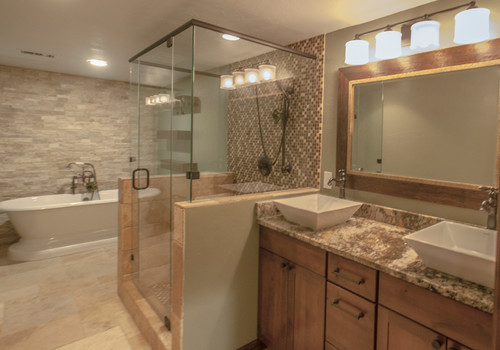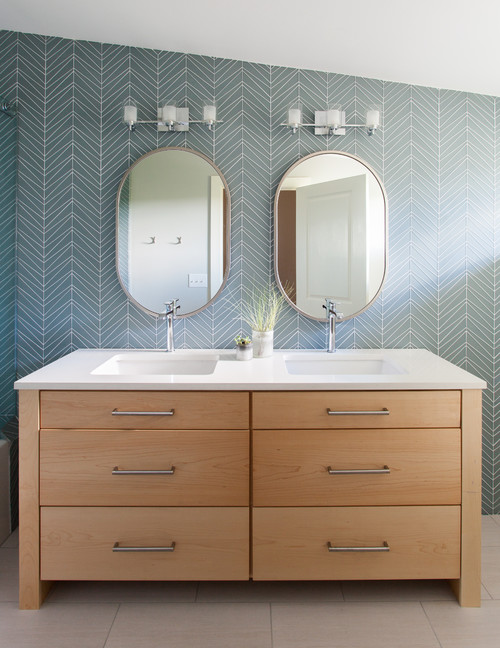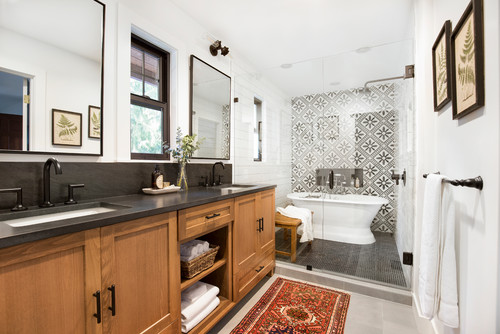Your Ultimate Guide On How To Keep Bathroom Cabinets From Mold
Learning how to keep bathroom cabinets from mold is a vital aspect of home maintenance, and at rtadepot.ca, we provide elegant and enduring solutions for this common challenge. A clean, healthy bathroom environment contributes positively to your daily life, and the foundation of this is high-quality, moisture-resistant storage. This comprehensive guide will explore every facet of bathroom cabinet mold prevention, from the underlying science to the financial implications, ensuring you have the definitive resource for protecting your home.
The persistent humidity in a bathroom creates the perfect conditions for mold and mildew to thrive, often unseen inside vanities and cupboards. This guide provides actionable strategies, from ventilation and material selection to cleaning and long-term maintenance. For residents in Mississauga, understanding these methods is key. We are here to help you master how to keep bathroom cabinets from mold.
1. The Science Behind Mold Growth in Bathroom Cabinets
Mold is a microscopic fungus that exists everywhere in our environment. It reproduces by releasing spores into the air. When these spores land on a damp surface with an organic food source, they can begin to grow. A bathroom cabinet, particularly if made from wood-based materials, provides the perfect trifecta of conditions: darkness, moisture, and sustenance. This is the core of the problem and the starting point for understanding how to keep bathroom cabinets from mold.
High humidity is the primary catalyst. Steam from showers and baths raises the moisture content in the air, a condition known as high relative humidity. The EPA suggests keeping indoor humidity below 50 percent to prevent mold growth. In a bathroom, this level is frequently exceeded. This excess moisture condenses on cooler surfaces, like the inside of a cabinet, providing the necessary water for mold to flourish. For many homeowners, this is a recurring issue, making the question of how to keep bathroom cabinets from mold a top priority.
1.1. Health Implications of Mold Exposure
Beyond being an eyesore, mold poses significant health risks. According to Health Canada, exposure can cause symptoms like eye, nose, and throat irritation, coughing, wheezing, and shortness of breath. For individuals with asthma, allergies, or compromised immune systems, the effects can be far more severe, potentially leading to chronic respiratory conditions. Certain molds produce mycotoxins, toxic substances that can lead to more serious health problems with prolonged exposure. This makes learning how to keep bathroom cabinets from mold a critical health and safety mandate for your family.
1.2. The Mold Lifecycle: Why It Spreads So Fast
Understanding the mold lifecycle reveals why quick action is crucial. It begins with a microscopic spore landing on a suitable surface. With moisture, the spore germinates, growing hair-like structures called hyphae. These hyphae branch out to form a network called a mycelium, which is the visible mold colony. As it matures, it develops new spores to release into the air, starting the cycle anew. The entire process can start in as little as 24 hours. Interrupting this cycle is fundamental to how to keep bathroom cabinets from mold effectively.
1.3. Understanding Relative Humidity and Dew Point
Relative humidity is the amount of moisture in the air compared to the maximum amount it could hold at that temperature. When warm, moist air (like from a shower) comes into contact with a cooler surface (like the back wall of a cabinet or a cold water pipe), it cools down. As it cools, its ability to hold moisture decreases. The temperature at which the air becomes 100% saturated and water droplets begin to form is called the dew point. Preventing surfaces inside your cabinetry from reaching the dew point is a scientific approach to the problem of how to keep bathroom cabinets from mold.
2. The Mississauga Climate Factor in Bathroom Mold Prevention
For homeowners in Mississauga, the local climate presents unique challenges. The warm, humid summers, influenced by lake effects from Lake Ontario, can increase indoor humidity levels. Conversely, the cold, dry winters lead to a different issue: condensation. When frigid outdoor air meets warm, moist indoor air on surfaces like windows and walls, water droplets form. This same principle applies inside the hidden corners of your bathroom. This makes the topic of how to keep bathroom cabinets from mold particularly relevant to residents of this region.
During Mississauga’s winter months, we seal our homes to keep the warmth in. This reduces natural air exchange, trapping moisture from daily activities inside. A long, hot shower can quickly saturate the air, which then condenses on cold water pipes or the back walls of your bathroom vanity. Addressing this seasonal dynamic is a critical component of a successful strategy for how to keep bathroom cabinets from mold.
2.1. Basement Bathrooms: A Special Challenge in the GTA
Basement bathrooms, common in many Mississauga homes, are at an even higher risk. Below-grade walls are naturally cooler, promoting condensation, and ambient humidity is often higher. Effective waterproofing, exterior drainage, and dedicated mechanical ventilation are not just recommendations but necessities for these spaces. A robust approach for how to keep bathroom cabinets from mold in a basement involves treating the entire room as a system, starting from the foundation and including the use of a subfloor membrane to create a thermal break.
3. What Is The Best Way To Ventilate A Bathroom?
The most effective way is using a mechanical exhaust fan with a CFM (Cubic Feet per Minute) rating appropriate for the room’s size. Current guidelines from the Home Ventilating Institute recommend a minimum of 50 CFM. For maximum effectiveness, the fan should run during a shower and for at least 20-30 minutes after to clear all moisture.
Proper ventilation is the most effective proactive measure you can take. The primary goal is to physically remove the moisture-laden air from your bathroom before it has a chance to condense. Relying on passive methods alone is often insufficient. An efficient mechanical exhaust fan is an indispensable tool in learning how to keep bathroom cabinets from mold.
3.1. Choosing the Right Fan: CFM, Sones, and Features
When selecting an exhaust fan, its CFM (cubic feet per minute) rating is the most important specification. A simple formula is to match the CFM number to the bathroom’s square footage. For instance, a 10-foot by 8-foot bathroom (80 sq ft) requires an 80 CFM fan. Also, consider the Sone rating, which measures loudness. A fan rated at 1.0 Sone or less is very quiet. A quieter fan is used more consistently, making it a better tool for how to keep bathroom cabinets from mold. Modern fans also have features like humidity sensors that automatically activate when moisture levels rise, providing a set-it-and-forget-it solution
3.2. The Critical Importance of Proper Ducting
An exhaust fan is only as good as its ductwork. The duct must be vented directly to the outside of the home—never into an attic, soffit, or wall cavity, which simply moves the moisture problem elsewhere. In cold climates like Mississauga, the ducting that runs through an unheated attic must be insulated to prevent condensation from forming inside the duct itself and dripping back down. Using rigid, smooth ducting is also preferable to flexible ducting, as it creates less air resistance, allowing the fan to work more efficiently. These details are central to a true solution for how to keep bathroom cabinets from mold.
4. Which Materials Are Best For Mold-Resistant Cabinets?
The best materials for preventing mold are completely waterproof or highly water-resistant. Polyvinyl Chloride (PVC) is 100% waterproof and will not support mold growth. High-grade plywood with waterproof adhesives offers excellent resistance. Lastly, moisture-resistant MDF that has been professionally sealed with thermofoil or a quality finish is a viable, cost-effective option.
Choosing the right materials is a foundational decision that can prevent future problems. When you are planning a renovation or building a new home, this choice directly impacts how to keep bathroom cabinets from mold. At rtadepot.ca, we prioritize materials that offer both beauty and exceptional performance in humid environments.
4.1. The Truth About MDF and Finishes
Medium-Density Fiberboard (MDF) is an engineered wood product. While standard MDF acts like a sponge, moisture-resistant (MR) grades are available. The true defense for MDF lies in its finish. A seamless layer of thermofoil, a high-pressure laminate, or multiple coats of polyurethane paint can create an impermeable barrier. However, a single deep scratch or crack in this finish can expose the raw MDF core to moisture, leading to swelling and failure. It can be a cost-effective choice if, and only if, the finish remains intact. This knowledge is key to how to keep bathroom cabinets from mold when using MDF.
4.2. Plywood: The Stable and Strong Workhorse
Plywood is made from thin layers of wood veneer glued together, with the grain of each layer running perpendicular to the next. This cross-graining makes it incredibly strong and dimensionally stable, resisting warping and shrinking. For bathroom applications, it is crucial to select furniture-grade plywood that uses waterproof adhesives, such as phenol-formaldehyde, to prevent delamination. While the wood itself can still get wet, its construction prevents it from falling apart like particleboard, making it a reliable foundation and a smart answer to how to keep bathroom cabinets from mold.
4.3. PVC: The Waterproof Champion
PVC (Polyvinyl Chloride) is a type of plastic that is completely waterproof. Bathroom cabinets made from solid PVC sheets are impervious to moisture. They will never swell, rot, or delaminate, and they offer no organic material for mold to consume. This makes them one of the lowest-maintenance and most durable options available for wet environments. For those seeking a definitive, worry-free solution for how to keep bathroom cabinets from mold, PVC is a leading contender.
4.4. Hardware Matters: Choosing Rust-Resistant Fittings
Your efforts can be undermined by poor hardware choices. Hinges, drawer pulls, and knobs made from low-grade steel can rust in a humid environment. This rust can stain your cabinet finish and, in some cases, the corrosion process can trap moisture against the cabinet surface. Always opt for stainless steel (grades 304 or 316 are excellent), zinc alloy, or solid brass hardware with a high-quality plated finish (like PVD, chrome, or nickel) to ensure longevity and prevent rust-related issues. This is a subtle but important part of a holistic strategy for how to keep bathroom cabinets from mold.
5. Financial and Real Estate Implications of Mold
A mold problem is more than just a health or aesthetic issue; it can have serious financial consequences. In a competitive real estate market like Mississauga’s, the presence of mold can significantly decrease a home’s resale value. It is a major red flag for potential buyers and home inspectors, often leading to costly remediation requirements before a sale can be completed or resulting in substantially lower offers. Investing in preventative measures is a direct investment in your property’s value, making the knowledge of how to keep bathroom cabinets from mold a sound financial strategy.
The cost of professional mold remediation in Canada can range from a few hundred dollars for a small, contained area to several thousand for a larger, more complex problem. Most standard home insurance policies have limitations or exclusions for mold damage, especially if it resulted from a long-term issue like persistent humidity rather than a sudden event like a burst pipe. This means the financial burden often falls entirely on the homeowner. A proactive mindset on how to keep bathroom cabinets from mold is your best insurance policy.
6. DIY vs. Professional Installation: A Cost-Benefit Analysis
Choosing between installing your new cabinets yourself or hiring a professional is a significant decision. A DIY approach can save money on labor, but it requires a high degree of skill, the right tools, and a significant time commitment. Mistakes like improper leveling can lead to sagging countertops and stress on plumbing, while poorly sealed cutouts can create immediate moisture problems, directly impacting your success in how to keep bathroom cabinets from mold. For complex projects, the risk of costly errors can outweigh the initial savings.
Hiring a professional installer, especially one familiar with the challenges of bathrooms in Mississauga homes, provides peace of mind. They have the expertise to ensure everything is perfectly level, securely fastened, and meticulously sealed. They can often foresee and mitigate problems a DIYer might miss. This professional touch is often the final, crucial step in guaranteeing a long-term solution for how to keep bathroom cabinets from mold.
7. A Detailed Guide to Mold Removal and Remediation
If you have discovered mold, addressing it safely is your immediate priority. This process, known as remediation, is a key skill in how to keep bathroom cabinets from mold. Before you start, always wear personal protective equipment: an N95 respirator mask, safety goggles, and rubber gloves.
1Containment and Preparation Before touching the mold, contain the area. Close any air vents and seal the bathroom doorway with plastic sheeting and tape to prevent spores from spreading throughout your home. If possible, place a small fan pointing out an open window to create negative air pressure. Carefully empty the contents of the cabinet, placing items in plastic bags to be cleaned later or discarded. This thorough preparation is the professional’s first step and is vital to a successful remediation, forming the foundational strategy for how to keep bathroom cabinets from mold.
2Cleaning the Surface The cleaning agent depends on the surface. For non-porous surfaces like PVC, metal, or a thermofoil finish, a simple solution of household detergent and water is sufficient to scrub away the mold. For porous wood surfaces, a 50/50 solution of white vinegar and water is more effective, as the vinegar’s acidity can kill the mold’s root-like structures. Apply the solution with a spray bottle, let it sit for an hour, then scrub with a soft-bristled brush. This cleaning technique is vital for how to keep bathroom cabinets from mold.
3Drying Thoroughly This is the most critical step. After scrubbing and wiping the surface clean, the area must be dried completely and quickly (within 24 hours). Use absorbent towels to remove all surface moisture, then employ fans and a dehumidifier to aggressively dry the cabinet materials. If the material has been saturated, this process can take a day or more. Incomplete drying is the number one reason mold returns, undoing all your hard work.
4When to Call a Professional If the mold covers an area larger than 10 square feet (roughly a 3-foot by 3-foot patch), if you suspect it is inside the wall or under the floor, or if the cabinet material is crumbling and soft, it is time to call a professional mold remediation service in Mississauga. Look for companies with IICRC (Institute of Inspection, Cleaning and Restoration Certification) credentials. They have the specialized equipment, containment procedures, and safety knowledge to handle extensive contamination safely, which is the ultimate answer to how to keep bathroom cabinets from mold in severe cases.
8. Long-Term Maintenance and Inspection Routines
Prevention is an ongoing process. Once your cabinets are clean or newly installed, a regular maintenance routine is the best way to ensure they stay mold-free. This proactive schedule is the secret to successfully managing how to keep bathroom cabinets from mold for the long term.
8.1. The “Bathroom Health” Calendar
- ✓Weekly: After the main bathroom cleaning, do a quick wipe of the inside of your main vanity with a dry microfiber cloth. Squeegee shower doors and walls after every use to reduce overall humidity in the room.
- ✓Monthly: Conduct a quick flashlight inspection of all plumbing under the sink. Look for any new drips, condensation, or water stains. Clear out and wipe down the interior of medicine cabinets. Deep clean the overflow drain in your sink, which can harbor mold.
- ✓Annually: Perform a detailed inspection of all caulk lines around the countertop, sink, and where the vanity meets the floor. If they are cracked, peeling, or show signs of mildew, it is time to remove the old caulk and apply a fresh bead of 100% silicone. If you have an exhaust fan, remove the cover and clean the fan blades of dust and debris. A clean fan is an efficient fan, which is key to how to keep bathroom cabinets from mold.
Is your outdated bathroom a constant source of worry? Are you struggling with cluttered spaces and the persistent threat of mold? The ultimate solution is a beautiful, modern, and expertly designed bathroom from rtadepot.ca. Our team of specialists, proudly serving the Mississauga community, is here to guide you toward a lasting solution.
Do not let frustration over your old cabinets continue. Contact us for a personalized consultation. Take the first step toward the serene and organized bathroom you deserve. Call us now at +1 888 973 5636 or visit our website at https://www.rtadepot.ca/ to explore our premium collection.














